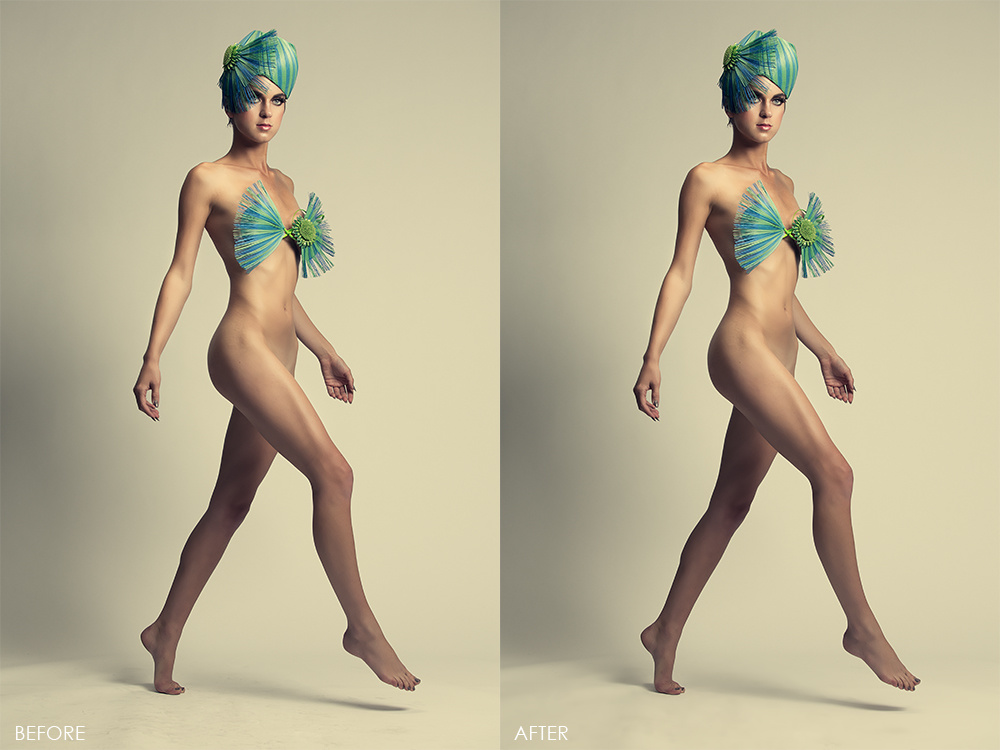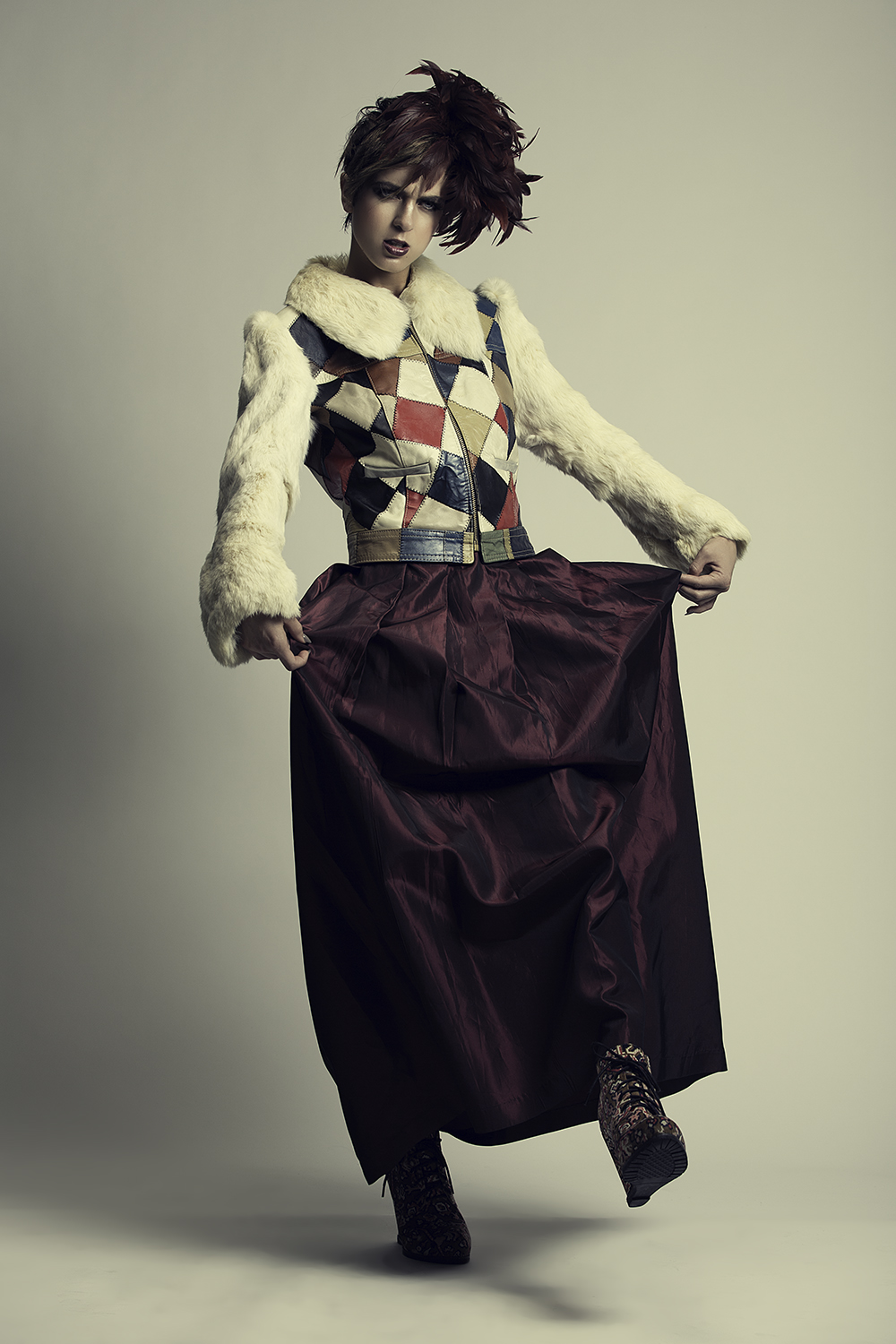If you’ve shot in any studio, then you know the rules. Larger studios may require the use of protective booties on a freshly painted cyc wall or some practice the unsaid "no shoes" rule when stepping onto background paper. But, unfortunately, that just doesn’t happen and if the subject is jumping or moving look after look that background is going to get dirty. We all know the pain of re-touching that dirt.
In my opinion, it’s probably one of the more annoying aspects of studio fashion re-touching, especially if you’re shooting on white seamless paper. It's so time consuming and perhaps so costly, that many photographers and editors just let it slip by without a second thought. But, after stumbling on a tutorial from my friend Aaron Nace of Phlearn, I truly believe my opinion had completely changed. I just had to give this method a try in my own video. What used to take 30 minutes with the Clone Stamp requires about 30 seconds with this method.
Create A New Layer. Type Ctrl-J (Command-J) or flatten all the layers into a new layer using Ctrl-Alt-Shift-E(Command-Option-Shift-E).
Add Median Noise. Click Filter > Noise > Median. Then select a Radius of 15 - 30 Pixels depending on the amount of dirt and grime on the background. In the preview window, make sure the dirt completely vanishes, but the shadows retain detail.
Create A Layer Mask. Click the Layer Mask button and then tap Ctrl-I (Command-I) to invert the mask.
Paint On The Median Blur. With a decent size white brush paint on the Median blur over the problem areas and watch the dirt disappear! Be careful of any edges, I recommend using a small brush to cover the fine details around shoes or props.
Add Noise. Although I do not mention this in the tutorial, reduce the blur banding by adding a slight touch(2%) of monochromatic noise to the original layer.
I've never claimed to be a fantastic re-toucher, I just share from experience and always try to pay the knowledge forward. This is one method that will come in handy time and time again.









Thats really cool, im sure i can find other uses for that technique, I wonder if it can be used to remove dust off reflective surfaces, it would definitely speed up some product shot retouches
Thanks for reading Mujtaba! I'm sure this technique has multiple uses! Give it a shot and would love to hear any feedback!
So I gave this a quick try on a dusty black surface on one of my product shots, and it works great!!...Yay!! no more spot healing hundreds of dust specs!!
That is awesome, great to hear man!
Cheers Clay! I was kicking myself today after shooting headshots on an crinkled white cotton backdrop. This technique helped fix the creases with ease.
That is awesome Luc! Thanks for reading! All credit goes to Aaron Nace over at Phlearn for showing us this awesome method!
Thanks for providing a step by step guide! You'd be surprised how often this is omitted when videos are included.
Of course! Thanks for checking it out!
Changing the game with this one!
Thank you for reading David! :)
Geez... this just proves that I need to search and play around with more filters lol
Thanks for sharing! I guess this will also work for small creases in a seamless too or inconsistencies
Thank you!
Thank you for reading and watching Christian! Really appreciate that.
Really, really wish I would have learned this before retouching my last project involving a bunch of rowdy high schoolers on a white seamless. Thanks to Clay and Aaron at Phlearn for sharing!
I hear ya! I wish I knew about this last year, it could have saved me so much time! Thanks for reading and watching Derek!
Right on time for my latest shoot! Thanks very much Clay!
You're very welcome Angel! Glad you've used the technique already!
I really did not know about this little trick. Thanks man!
Sure thing Federico! Thanks for reading, I always try to pay the knowledge forward.
WOW my mind is blown. Thats going to save hours and hours in post. THANK YOU for sharing.
Thank you so much Michael! Really appreciate you reading!
Love it Clay! I used to use a similar technique at a mom and kids fashion company I used to work for...it's a great trick and really does save a ton of time!
That is awesome, it has really saved me hours! Really appreciate you reading the article.
yes ..another useful tutorial... thanks for sharing.
Thanks for reading Robert!
I now wonder what Fstoppers "ORIGINAL" means.... no matter Aaron agrees to copy here...
Tom, we are all good friends with Aaron and the team at Phlearn. To be fair, this technique has been public knowledge for sometime. Aaron and myself have just brought it to the surface(more so Aaron). The original comes from the fact that this is all my original work and video. I'm just here to pay the knowledge forward! Thanks for reading!
Thank you so much!!! Spent many hours cleaning the seamless back drops! This is a good one Clay!
Thank you brother!
Man, that's pretty wicked. I can't tell you how many hours I have spent in the past cloning out garbage on seamless. You da man!
Thanks Ray! Glad this could be an amazing help for you!
I just heard the sound of 1000s of assistants simultaneously celebrating the fact that they can spend less time painting cycs
LOL! That's awesome! Thanks for reading Jake!
Really interesting, I've never used this method with the noise option. I use to apply a similar technique with a surface blur that works fine in many situations. Not sure what pros and cons has one technique agains the other but it is always welcome the fact of have more tools to apply depending on the picture :)
Thanks for reading Rafa! There are probably many ways to clean and paint out background dirt. This is just one of them! :)
If your working on 16bit you should also add noise and despeckle, otherwise it'll look blotted out.
Good advice Ishmil!
Simple and great !! Thank you Clay :)
Thanks for reading Rafael!
In short: I'm impressed. Thank you Clay, thank you Aaron for sharing this great technique.
Simplicity is the mark of genius.
Thank you so much Michael! Totally nailed it there.
Oh really thanks for sharing this stuff, i learned a lot always with this page and Phlearn. :D
Awesome Yami! Thanks for reading and watching!
Incredible! I can't tell you how much time this is going to save me every year during my dance and gymnastics photo shoots!!! All these years I thought the patch tool was my best friend...she's dead to me! haha!
Well! this made my day. Thanks
Super - that's a solution I've been looking for for a long time!
Clay you dah man, this is friggin' amazing. You just saved me hours of work! (literally, from 30 mins to 5 mins for one photo) You've saved me today. This technique got rid of some stray hairs as well. Thanks!
I have to log in to say : awesome method !!! thanks for sharing this :D